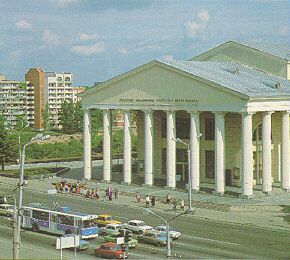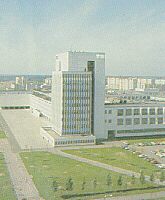
Vitebsk history

Vitebsk (Viciebs or Witebsk) is a Belarussian city situated on the North-East of the Belarus in the land of glacier lakes on the picturesque banks of the three rivers: the Zakhodnyaya Dzvina (in Russian - Zapadnaya Dvina, in old Belarusian -Rubon, in Latvian - Daugava) river, the Vitba and the Luchesa river. It is one of the oldest settlements in Europe. According to a legend Vitebsk was founded in 974 by Princess Olga of Kiev after successful campaign against the Baltic tribe Jacviahi. But the first information about the town in chronicles was in 1021. It had sprung up on a busy road "from Varangians to Greeks" and stood witness to a great number of glorious events and heroic deeds. Since early times the town had been known as a "warrior". So it is not by chance that its ancient emblem featured a horseman holding a spear and shield.
Vitebsk was an important fortress and merchant center at the north-eastern border of the Polatsak Principality and later of the Grand Duche of Lithuania (GDL); a famous medieval state which became the cradle of Belarusians and Lithuanians. Vitebsk was included into the GDL in 1320 and its citizens obtained some merchant privileges and a self-government. In 1597 Vitebsk was granted the Magdeburg Code of Law.
On July 15, 1410 a troop of armed Vitebsk citizens took part in a glorious battle near Grunwald (in Eastern Prussia) where united army of the Grand Duche of Lithuania, the Polish Kingdom and volunteers from the Czech Kingdom won the army of German knights (Tevton Order).
The dramatic page in the town's history is its people's revolt of 1623 when they overthrew and drowned in the Zapadnaya Dvina the odious Iosafat Kuntsevich who was trying to put the Unia yoke upon the people.
In XVI-XVII centuries Vitebsk much suffered from aggressive wars of the Moscow Principality (later Kingdom) against the GDL. About every year numerous but poorly armed hordes of Muscovites ruined Eastern Belarus. Vitebsk was burned to a crisp by soldiers of Ivan the Terrible (XVI century), of the czar Alexei Mikhailovich (XVII century) and of Peter the First (1708).
After unification with Russia (1772) Vitebsk became an ordinary provincial town of a huge military empire. Culture, public education, science and health service developed at a rapid pace.
During the Napoleon campaign in Russia (1812) Vitebsk noblemen supported Frenchmen because the latter promised to restore self-government in the former Polish - Lithuanian kingdom, but Belarusian peasants were mobilizing by Russian army. In 1812 Vitebsk was burned again. After war ended among few other cities Russian czar ordered to put in Vitebsk the monument in honor of 1812 battles.
In 1840 after suppression of 1830-1831 insurrection Russian government abolished ancient Belarusian constitution (the famous 1588-year Statute of the GDL) and open Russian colonization of Belarus began.
The World War II was a very serious trial for Vitebsk people. Soviet Army soldiers and people's voluntary detachments did their best to save the town. Yes, it was captured by Hitler's invaders but never subdued.
On the June 26, 1944 day Red Army troops cleared the town of fascist occupants laid in ruins and only 118 people survived in the basements from about 170 000 of population before the war. Only in the end of 60s population of Vitebsk achieved the level of 1939.
Since then every year Vitebsk people celebrate this date. In its centuries long history Vitebsk had never been devastated like that. The town's new life began after the liberation. New factories, plants, dwelling houses, schools, hospitals, streets and avenues were built in place of the charred ruins.

Vitebsk today is a major industrial, scientific and cultural center of the republic Belarus.
Cultural life flourishes in Vitebsk as well. The Belarusian State Academic theater named after Yakub Kolas is one of the oldest in the state. Picturesque neighborhood of Vitebsk and its ancient streets was always attractive for painters.
Vitebsk was the native land of Mark Chagall, the world famous artist, who died in Paris but he always dreamed about Vitebsk. He was inspired by his native town of Vitebsk, which he often depicted in his works.
A famous Russian painter Iliya Repin lived and worked near Vitebsk during some years in the end of XIX century. Some of his works are presented at the Vitebsk art museum.
Although Vitebsk much suffered from numerous wars, some architectonic sights are saved such as: Rathaus (Coloncha, former City Hall) (1775), Governor's palace (before 1772), St.Barbara's Catholic church (1785, rebuild in end of XIX), St.Michael church (XVIII century), some buildings of Basilian and Bernardin Catholic monasteries (XVIII century) and some nice quarters of old town. Before the Governor's palace a monument in honor of 1812 battles near Vitebsk was stated in 1912.
In 1988 Vitebsk was chosen to hold Slavic Bazar musical festival that gathers hundreds of musicians from all around the world who sings songs on Slavic languages and attracts thousands of tourists. The festival is a major event in the city's life.
